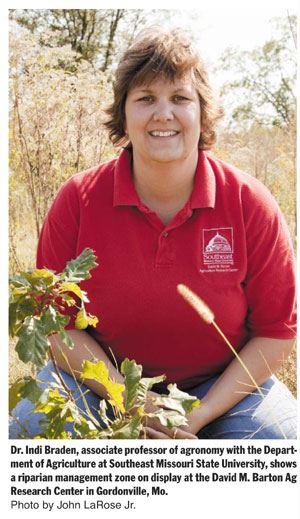A Conservation Lesson
Riparian Management Zone Saves Water, Soil And Nutrients
GORDONVILLE, MO.
A study of a riparian management zone was on display recently at the David M. Barton Ag Research Center in Gordonville. Dr. Indi Braden, associate professor of agronomy with the Department of Agriculture at Southeast Missouri State University, showed the system.
“We have several focus research areas that we use to instruct our students for a hands-on experience; also we provide demonstrations to producers,” Braden said. “Part of the demonstrations include environmental quality, water quality, best management practices that can be used with crops, soils and water on your farm.”
An example of a riparian management zone was behind her as she spoke. This 25-foot buffer zone of native warm season grasses and switchgrass, followed by 75 feet of native trees helps hold the water and nutrients in the soil.
“We have five different species of trees that are planted here for demonstrations. Students planted all of the trees as experiential learning,” she said. “We also received a grant so that we could provide for workshops to demonstrate best management practices to those in our surrounding community.”
A long concern of watershed areas is loss of a lot of high quality nutrients from a row crop area into the water. The riparian management zone is an effort to keep nutrients on the farm, stop the loss of water and nutrients or slow the loss down before it actually gets into the waterway and goes downstream to someone else’s farm. As a way to reduce soil loss, a riparian buffer strip is an effort to hang onto sediment, slow or stop it at the vegetative buffer strip where it’s easier to manage or redistribute onto your farm.

“One of the results that we see from implementing management practices such as the riparian management zone is retaining your soil, reducing the soil loss on your farm. By keeping it on your farm you are reducing some of the silt loads that wind up in the creeks,” she explained.
“You’ll also see that the amount of nutrients leaving your farm is reduced. Dr. Michael Aide, myself and Dr. Wes Mueller, as well as other faculty in our department and students have collected research on water that is leaving the farm; what we’ve seen in the results is reduction in nutrients leaving this farm. Part of that is the best management practice of managing your farm losses of water, nutrients and sediment. We have an underground irrigation system or subsurface irrigation system whereby we can control, water drainage or irrigation. For example, you can retain the water underground until your plants need it and keep water and nutrients from running down the stream.”
A second management practice is the riparian buffer strip or riparian management zone, which builds plant material above and below ground while the root systems hold onto that moisture and the associated nutrients before it leaves this farm.
“We’ve seen a lot of reduced loads on nitrates, on phosphorus that otherwise would have left the farm,” Braden said. “So we want to keep our fertilizer on the farm and use it for our crop.
“Our take-home message is we actually are providing hands-on experience for our students, showing them the real world practices of what we teach them in the classroom,” she continued. “We want them to be on the farm seeing the logical, practical daily use of water and nutrient saving practices. We also want them to see the scientific change that is being made.“
They work with the data, they analyze some of the samples and are amazed at how much less material is being lost than the previous year.
“These are the results of some management changes that have helped us save our water, soil and nutrients while providing hands-on learning for students,” she said. Δ
BETTY VALLE GEGG-NAEGER: Senior Staff Writer, MidAmerica Farmer Grower